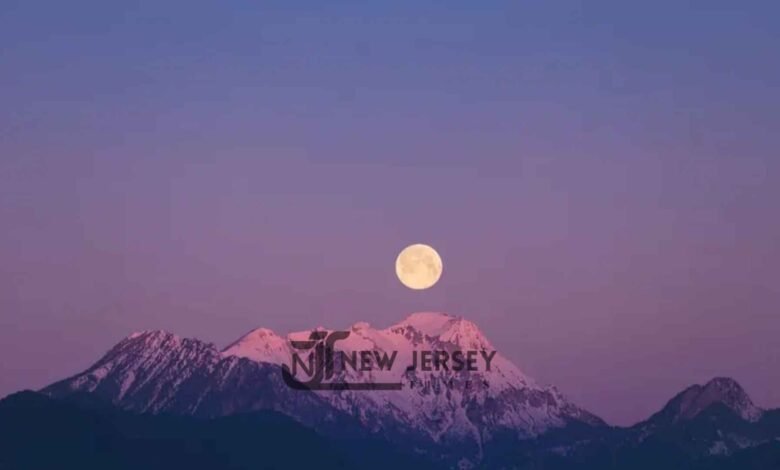Strawberry Moon and Milky Way Dazzle Indian Skywatchers in Rare Celestial Showcase
June’s full moon rises low across India amid rare lunar standstill, with planets and the Milky Way joining the night spectacle

Table of Contents
Something curious is happening in the sky tonight—and it’s not just for scientists or telescope buffs. It’s the Strawberry Moon, rising low and luminous, marking not only a seasonal moment but one of the rarest lunar displays in years.
A Low-Hanging Moon and a Much Older Clock
This isn’t your average full moon. If you catch it just after sunset, especially near the eastern horizon, you might notice something odd. It looks lower. Flatter. Maybe even larger than usual. That’s not a trick of the camera—although smartphones will surely be busy tonight—it’s a result of something called a major lunar standstill, a phrase that sounds technical, but the outcome is anything but dry.
In short: the moon’s orbit tilts in a way that drags it closer to the horizon. This tilt, caused by the gravitational nudge of the sun over time, hits a maximum point every 18.6 years. We’re in one of those peaks right now, and according to EarthSky, this full moon will be the lowest visible from the Northern Hemisphere in decades.
The last time this happened? Back in 2006. And the next one? You’ll be waiting until 2043. So, tonight’s view really is once in a generation.
Why It’s Called the Strawberry Moon—And Why That Matters
Despite the romantic name, the moon won’t look pink or berry-like. The name goes back to the Anishinaabe and other Native American groups who named moons based on seasonal cues—strawberries ripened around this time. Other tribes had their own variations. The Creek people called it the Blackberry Moon. The Shawnee knew it as the Raspberry Moon. These names weren’t poetry for poetry’s sake; they were tools for marking time and harvest.
It’s interesting how modern astronomy still nods to these old-world names. Even in parts of India, lunar phases are stitched into calendars and rituals. There’s something reassuring about that.
Not Just the Moon—Look Up a Little Longer
If you’re lucky enough to be in a darker part of the country—away from Mumbai’s sodium vapour haze or Delhi’s fluorescent sprawl—you might just glimpse the Milky Way tonight. June marks the start of what NASA calls “Core Season,” when the dense, glowing centre of our galaxy becomes visible in the night sky. It’ll appear as a pale, arcing band stretching across the heavens, best seen after the moon dips low.
The Milky Way’s core isn’t something you stumble on every night. It takes patience. You’ll need time for your eyes to adjust, and maybe a jacket if you’re in a breezy part of the Western Ghats. But it’s worth the wait. With a long exposure shot, you’ll see something resembling a stitched quilt of starlight—layers of dust and ancient gas clouds that tell a much older story.
Planets Sneaking into the Scene
There’s more to this show. If you stick around after sunset, look west. You’ll see Mars, Jupiter, and Mercury lining up—faint, steady lights just above the dusky skyline. Venus, the morning star, is holding court in the east before sunrise. On June 22, it’ll cozy up next to a crescent moon, offering a rare pre-dawn tableau.
No telescope? No problem. Just look where the sky fades from orange to indigo. If it’s clear, you’ll spot them.
Ancient Stones and Moonlit Alignments
While the modern world may mark events like these with Instagram stories and news blurbs, ancient communities treated them as monumental. Literally. Stone circles in Scotland’s Hebrides, and sacred sites in New Mexico, are built in alignment with lunar standstills. The people who constructed them didn’t have apps. What they had, though, was time, sky, and generations of careful watching.
Even today, the moon plays roles in Indian festivals, fasts, and calendars. Its presence is more than decorative—it’s functional, sometimes sacred, always reliable.
What to Know If You’re Heading Out
- The best time to see the Strawberry Moon is shortly after sunset on June 10, looking east.
- For the Milky Way, wait until later in the night—ideally past midnight—and scan toward the south.
- Dark skies matter. Cities will likely wash out the dimmer stars, but you might still catch the moonrise.
- Planets like Mars, Jupiter, and Mercury show best in the west right after sunset. Venus appears pre-dawn.
Bring a sweater, maybe a tripod if you’re into photography, and don’t forget to look up for longer than a few seconds.
Looking Ahead: Eclipses and More Moons to Come
According to the Farmer’s Almanac, we’re only halfway through the lunar year. Here’s what’s left:
- July 10 – Buck Moon
- August 9 – Sturgeon Moon
- September 7 – Corn Moon
- October 6 – Harvest Moon (supermoon)
- November 5 – Beaver Moon (supermoon)
- December 4 – Cold Moon (supermoon)
And come September, we’re in for two more headline events. A total lunar eclipse on the 7th–8th, visible across parts of Asia, Africa, and Europe, followed by a partial solar eclipse on September 21, visible in regions closer to Australia and the Pacific.
Tonight Is About More Than Astronomy
The truth is, most people won’t be thinking about orbital mechanics or gravitational shifts. They’ll be watching from a balcony, standing beside someone they care about, or just quietly marvelling on their own. No hashtags, no filters—just the old sky doing what it’s always done.
And for a moment, maybe, that’s enough.
New Jersey Times Is Your Source: The Latest In Politics, Entertainment, Lifestyle, Breaking News, And Other News. Please Follow Us On Facebook, Instagram, And Twitter To Receive Instantaneous Updates. Also Do Checkout Our Telegram Channel @Njtdotcom For Latest Updates.





